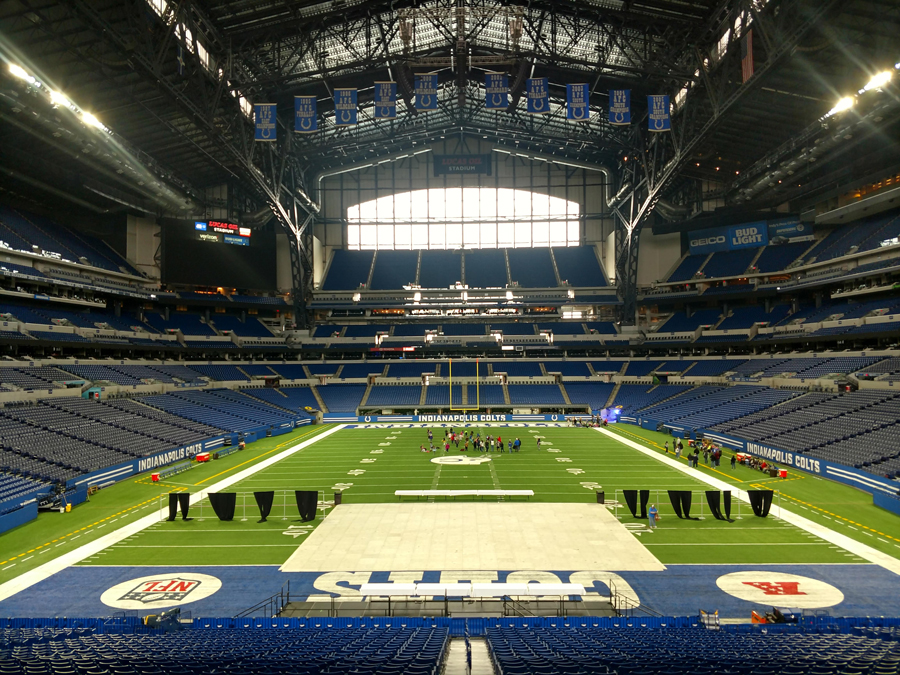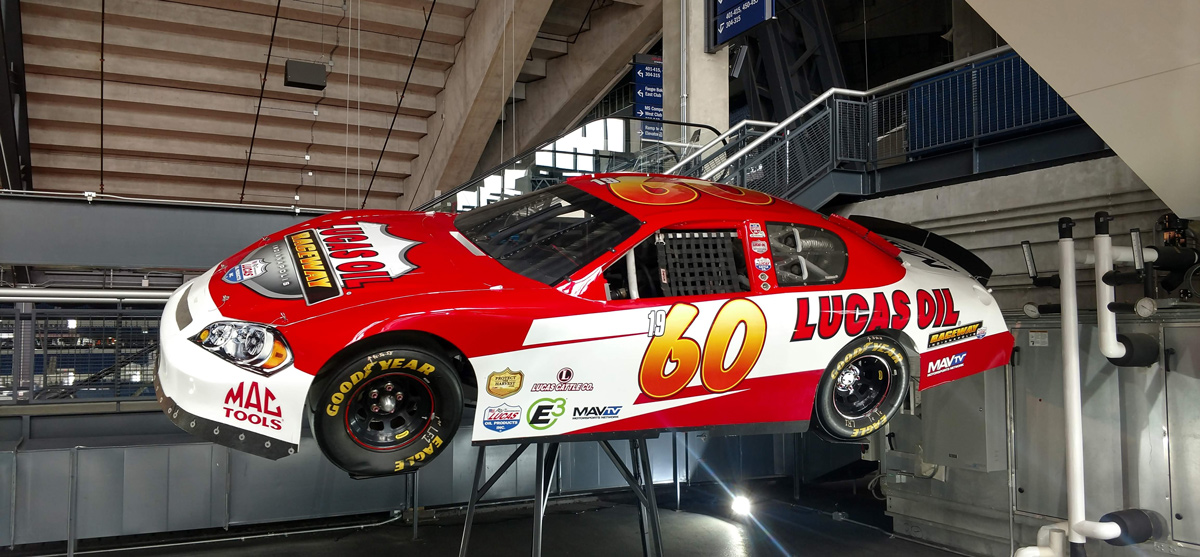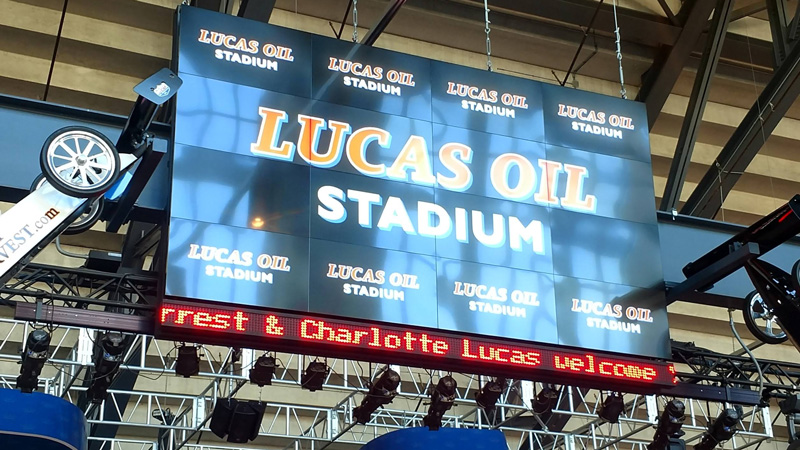Case Study: Lucas Oil Stadium
AV over IP Powers Digital Signage at Lucas Oil Stadium
Download the Case Study PDFOmniStream worked with our existing wired infrastructure since we had twisted pair wiring from our central rack to the various displays. Furthermore, OmniStream could operate with multicast transmission applied to each switch.
Lucas Oil Stadium is a state-of-the-art multi-purpose facility seating over 67,000 fans with a retractable roof. Opened in 2008 as the new home of the NFL’s Indianapolis Colts, its flexible design can also accommodate NCAA basketball, and concerts among other national and local events.
The seven-level stadium design has embraced AV and digital signage technology since opening its doors. Located on the north street level of Lucas Oil Stadium lies Lucas Oil Plaza, a public congregation area for events and concessions featuring a multitude of performance motor vehicle exhibits. The plaza’s original digital signage network included 13 single displays and a 16-screen, 4×4 video wall, blending Lucas Oil promotional content with entertainment.
In operation for 10 years, the original AV/digital signage system was due for an update: DVD players and monitors stationed at remote kiosks required manual control; older-generation content servers had reached the end of operational life and the monitors in the main 4×4 video wall had begun to fail. Overall, a new centralized source and control system was needed for video playback, remote powering, and system management.
Given these issues and the opportunity to significantly improve the fan experience, the decision was made to substantially update the Lucas Oil Stadium network in two phases: First, a new digital signage network deployment; and second, an engaging video wall that would breathe new life into the overall fan engagement. In both cases, the new network, comprised of seven motor sports-themed displays and a more dynamic 16-screen video wall would be more automated, visible, energy-efficient, scalable, and pleasing to the eye.

“Moving to IP made sense as a common infrastructure that could scale easily and support new applications and technologies as their AV vision evolves.”
– Cory Poore, IT and Network Technicianm, Lucas Oil Plaza
Migration to the Network
While the Lucas Oil Plaza signage network has always had a broad footprint, the content has been simple. The previous content servers fed PowerPoint slides and content from DVD players and laptops to the various endpoints. However, the expense of maintaining the original system coupled with its fading reliability clearly pointed to a new strategy.
The Plaza’s existing wired infrastructure was repurposed and provided plenty of bandwidth to distribute video and control content over IP. This steered the customer toward an AV over IP architecture to support the second-generation digital signage network that leveraged Atlona for networked switching, distribution and control.
“As IT technicians, we were at home managing systems over IP networks,” said Cory Poore, IT and Network echnician, Lucas Oil Plaza. “They are far more dynamic and flexible than working with legacy circuit-based systems, where your operation is fairly limited to its original premise at the time of installation. Moving to IP made sense as a common infrastructure that could scale easily and support new applications and technologies as their AV vision evolves.”
The migration to IP also overcame many potential signal and distance limitations inherent in legacy systems. As large as Lucas Oil Plaza is, they wanted a system that could achieve greater signal distribution distances, and easily add PoE network repeaters when and where necessary.
Atlona’s OmniStream™ AV over IP platform proved the ideal choice for switching and distribution over the network.
“There was an immediate benefit from the integration perspective,” said Poore. “OmniStream worked with our existing wired infrastructure since we had twisted pair wiring from our central rack to the various displays. Furthermore, OmniStream could operate with multicast transmission applied to each switch. This would avoid sending AV traffic to network devices that did not require it, saving bandwidth and eliminating device potential lockups due to related network traffic.”
In addition to the single displays, the OmniStream rack feeds the Plaza’s 4×4 video wall. The video wall’s location prevented any feasible option to install (16) separate twisted-pair runs to the decoders behind each display. Instead, they leveraged a single high-bandwidth infrastructure.
“We opted for a 10Gb copper CAT6a backbone from the core switch to all other switches, which further preserves network bandwidth,” said Poore. “Having a detailed static IP address allocation for all devices also proved essential to ensure system stability and reliability, avoiding any potential shifting IP addresses or IP conflicts.”
The OmniStream source distribution is comprised of three OMNI-112 dual-channel IP encoders and an OMNI-111 single-channel IP encoder. This is all located in a central equipment rack with the source equipment and two Cisco SG350X-24MPP core network switches. In the plaza, a total of 23 OMNI-121 single-channel IP decoders feed the screens, with one decoder assigned to each display (16 supporting the video wall and seven supporting the exhibit displays). An additional two network switches were added behind the video wall to support the OmniStream decoders and each display’s LAN communication.
PoE capability allowed us to centrally manage power to the OmniStream encoders/decoders, and all digital signage content is reliably disseminated with visually lossless video quality, and no noticeable signal latency.

“OmniStream worked with our existing wired infrastructure since we had twisted pair wiring from our central rack to the various displays. Furthermore, OmniStream could operate with multicast transmission applied to each switch.”
– Poore
Reimagined Signage
Integration of the exhibit displays and video wall first required a significant tear down phase. The outer panels of the existing video wall enclosure were stripped down to its frame, and a total of 8, 16’ sections of horizontal channel strut were added for the new display mounts to attach to. New CAT6A UTP cabling was also pulled to the video wall to provide plenty of bandwidth for multiple simultaneous video sources to be displayed, if desired.
Once the exhibits were prepared, the installation team began the process of installing the new screens. The new video wall is comprised of 16 LG 55VX1D landscape screens, with Chief ConnexSys™ mounts supporting the displays. These are precision mounts offering six points of adjustment across height, tilt, depth and lateral movement.
The digital signage displays are fashioned into creatively-themed kiosks, with positioning in key traffic areas – some of which were repositioned for more visibility to the fans. Two, 86” LG landscape displays were added to the restrooms, dual LG 42” landscape displays were added to two Oil Bottle exhibits, dual Elo 17” portrait displays were added to two antique Gas Pump exhibits, and a single LG 49” landscape display was added to a performance motor tear down exhibit. Video content is currently 1080p HD, though higher resolutions can be supported in the future.
“OmniStream will support 4K content, though we currently distribute HD content – a big step up from the analog-only video support of the previous architecture,” said Poore. “We can also inject live sources into the network for the first time; when delivered from laptops or plug-in sources, an Atlona HD-SC-500 three-input scaler upconverts the content.”
Upping the Control Game
The move to centralized control using the Atlona Velocity™ control platform over the network has perhaps been the greatest operational efficiency boost, according to Poore.
“In addition to eliminating our manual and siloed approach to control on site, it has liberated the staff through remote control operation,” he said. “We can remotely connect to control the system, troubleshoot issues, and update the system’s configuration among other benefits. We can also control the system from smartphones and tablets utilizing the intuitive tap-and-drag UI that Atlona’s Velocity provides and we are familiar with in our everyday lives.”
Ease of configuration was an immediate benefit. Velocity’s web-based configuration software includes a large number of pre-defined devices in its database – in fact, technicians only had to custom-configure one driver for an audio matrix.
“We took advantage of the system’s event macros to automate many of the processes as the configuration progressed,” said Poore. “This was achieved via a simple pull-down menu and selecting the event and action to be performed. Based on our evaluation of control systems, Velocity has a very extensive driver database.”
Perhaps the most beneficial aspect was the simple assignment of inputs and outputs for the OmniStream distribution network. Specifically, there were no manual command steps required to map encoder inputs to decoder outputs, which accelerated the video routing configuration process. The programming for this element was automated behind the scenes, so it understands how to map outputs based on drag-and-drop events.
Beyond leaving behind the manual control processes of Lucas Oil Plaza’s first-generation system, the remote management features of the new system deliver the greatest operational value.
“Velocity’s user interface is clean and uncluttered, which allows me to view the system and easily talk technicians through an operating process or a troubleshooting issue as needed,” said Poore. “To perform my own remote service, it’s as simple as accessing the menu and configuration on my smartphone.”
The system is still modest enough where the customer doesn’t require the Velocity Cloud service. Control requests are processed through the Velocity VGW-250 Gateway, which is connected to a rack-mount 15-inch Elo Touchscreen PC.
“We have customized the Elo touchscreen to operate in kiosk mode and display the Velocity user interface,” said Poore. “The UI is web-based and responsive, allowing us to toggle almost any element on and off. The benefit is customization to suit any environment or user.”
While Poore says there are no immediate plans to further expand the system, he emphasizes that Lucas Oil Plaza now has the IT network and AV system infrastructure well-prepared to accommodate future changes.
“We are considering options to connect video cameras and social media feeds to the signage network, particularly for presentation on the video wall,” he said. “Our second-generation network is architected to accept and inject live sources, which is a big change from before.
“At any rate, moving to AV over IP means we are no longer boxed in by a fixed switcher and input/output limitations,” concluded Poore. “Should we opt to add more displays, it’s as simple as making the routing and control connections to manage our signage content.”
| PRODUCTS FEATURED | PRODUCTS FEATURED |
| Model | Description |
| AT-OMNI-111 | Networked AV encoder for one HDMI source up to 4K/UHD, plus embedded audio and RS-232 control |
| AT-OMNI-112 | Networked AV encoder with two independent channels of encoding for two HDMI sources up to 4K/UHD, plus embedded audio and RS-232 control |
| AT-OMNI-121 | Networked AV decoder for an OmniStream-encoded video stream up to 4K/UHD, as well as embedded audio and RS-232 control |
| AT-HD-SC-500 | A 3×1 switcher and HD scaler with two HDMI inputs and a VGA input with audio. It is designed to take video signals from switchers, PCs, or laptops, and scale them to an HDMI output at a wide range of resolutions and rates, up to 1080p @ 60 Hz and 1920×1200. |
| AT-VGW-250 | An AV control processor for the Atlona Velocity Control System. The VGW-250 is capable of serving up to 250 simultaneous IP device connections for Atlona and third-party AV devices, Velocity touch panels, and BYOD control from web browsers and mobile devices. |








